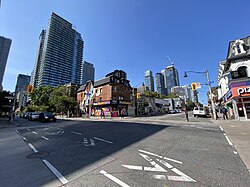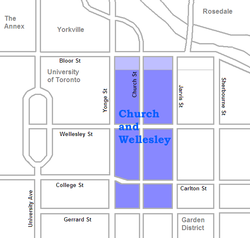
A gay village, also known as a gayborhood, is a geographical area with generally recognized boundaries that is inhabited or frequented by many lesbian, gay, bisexual, transgender, and queer (LGBT) people. Gay villages often contain a number of gay-oriented establishments, such as gay bars and pubs, nightclubs, bathhouses, restaurants, boutiques, and bookstores.

Davie Village is a neighbourhood in the West End of Vancouver, British Columbia, Canada. It is the home of the city's LGBT subculture, and, as such, is often considered a gay village, or gaybourhood. Davie Village is centred on Davie Street and roughly includes the area between Burrard and Jervis streets. Davie Street—and, by extension, the Village—is named in honour of A.E.B. Davie, eighth Premier of British Columbia from 1887 to 1889; A.E.B's brother Theodore was also Premier, from 1892 to 1895.

Queen Street is a major east–west thoroughfare in Toronto, Ontario, Canada. It extends from Roncesvalles Avenue and King Street in the west to Victoria Park Avenue in the east. Queen Street was the cartographic baseline for the original east–west avenues of Toronto's and York County's grid pattern of major roads. The western section of Queen is a centre for Canadian broadcasting, music, fashion, performance, and the visual arts. Over the past twenty-five years, Queen West has become an international arts centre and a tourist attraction in Toronto.

Enza Anderson is a Canadian journalist, media personality, Ontario politician, and transgender rights activist.
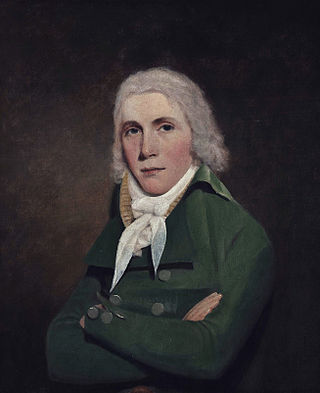
Alexander Wood was a Scottish merchant and magistrate in Upper Canada who was the centre of a sex scandal in 1810.

Gay Village is a neighbourhood delineated by Saint Catherine Street East and Atateken Street in the Ville-Marie borough of Montreal, Quebec, Canada.
Glad Day Bookshop is an independent bookstore and restaurant located in Toronto, Ontario, specializing in LGBT literature. Previously located above a storefront at 598A Yonge Street for much of its history, the store moved to its current location at 499 Church Street, in the heart of the city's Church and Wellesley neighbourhood, in 2016. The store's name and logo are based on a painting by William Blake.
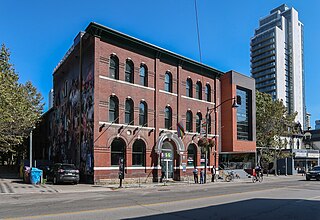
The 519, formerly known as The 519 Church Street Community Centre, is an agency by the City of Toronto. A Canadian charitable, non-profit organization, it operates a community centre in the Church and Wellesley neighbourhood of Toronto, Ontario, Canada. The 519 serves both its local neighbourhood and the broader lesbian, gay, bisexual and transgender (LGBT) communities in the Toronto area. The 519 defines its local neighbourhood by a catchment area that spans from Bloor Street to the north to Gerrard Street to the south, and from Bay Street in the west to Parliament Street in the east.
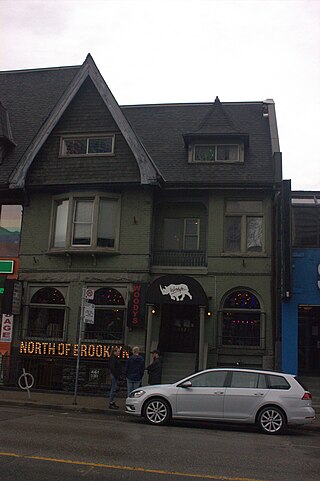
Woody's on Church is a gay bar located at 467 Church Street at the gay village in Toronto, Ontario, Canada.
This is a timeline of notable events in the history of the lesbian, gay, bisexual and transgender (LGBT) community in Canada. For a broad overview of LGBT history in Canada see LGBT history in Canada.
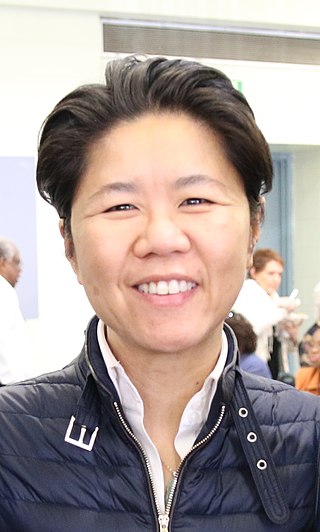
Kristyn Wong-Tam is a Canadian politician who has represented Toronto Centre in the Legislative Assembly of Ontario since 2022 as a member of the Ontario New Democratic Party (NDP).
Although same-sex sexual activity was illegal in Canada up to 1969, gay and lesbian themes appear in Canadian literature throughout the 20th century. Canada is now regarded as one of the most advanced countries in legal recognition of lesbian, gay, bisexual, and transgender (LGBT) rights.

The Birmingham Gay Village is an LGBT district next to the Chinese Quarter in Birmingham city centre, centred along Hurst Street, which hosts many LGBT-friendly businesses. The village is visited by thousands of people every week and has a thriving night life featuring clubs, sports bars, cocktail bars, cabaret bars and shops, with most featuring live entertainment including music, dancing and drag queens.
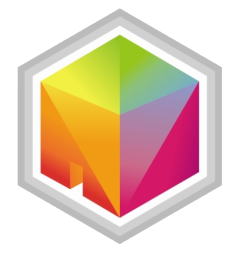
Pride House is a dedicated temporary location which plays host to lesbian, gay, bisexual and transgender (LGBT) athletes, volunteers and visitors attending the Olympics, Paralympics or other international sporting event in the host city. The first was organized for the Vancouver 2010 Winter Olympics.
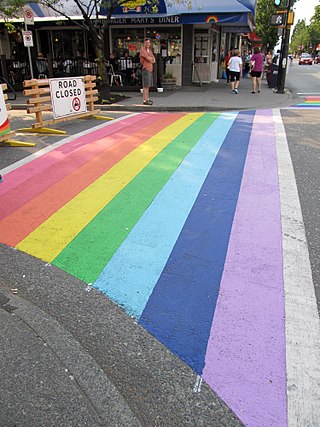
Vancouver's LGBT community is centered on Davie Village. Historically, LGBT people have also gathered in the Chinatown and Gastown neighborhoods. Former establishments include Dino's Turkish Baths, a gay bathhouse on Hastings, and the city's first drag bar, BJ's, on Pender Street.
Alloura Wells was a Canadian transgender mixed-race woman who died in Toronto in July 2017. Her body was discovered in a ravine the following month, but she was not reported missing until 6 November 2017, and her badly decomposed body was not identified until 23 November.

The ongoing COVID-19 pandemic has highlighted inequities experienced by marginalized populations, and has had a significant impact on the LGBT community. Gay pride events were cancelled or postponed worldwide. More than 220 gay pride celebrations around the world were canceled or postponed in 2020, and in response a Global Pride event was hosted online. LGBTQ+ people also tend to be more likely to have pre-existing health conditions, such as asthma, HIV/AIDS, cancer, or obesity, that would worsen their chances of survival if they became infected with COVID-19. They are also more likely to smoke.

Michelle Ross was the stage name of Earl Barrington Shaw, a Jamaican Canadian drag queen who was active from 1974 until her death in 2021. She was considered one of the key icons of the LGBTQ community in Toronto, especially for Black Canadian members of the community.

A statue of Alexander Wood was erected in Toronto, Ontario, Canada, by the Church Wellesley Village Business Improvement Area (CWVBIA) and the municipal government of Toronto on May 28, 2005. Designed and constructed by artist Del Newbigging, the 244-centimetre-tall (8 ft) bronze sculpture was installed at the corner of Church and Alexander Streets in Church and Wellesley, the gay village of Toronto. It was the first LGBT monument in Canada. The statue was removed and destroyed by the CWVBIA on April 4, 2022, amid renewed focus on Wood's ties to a group that raised funds for a mission school that later became the Shingwauk Indian Residential School.
